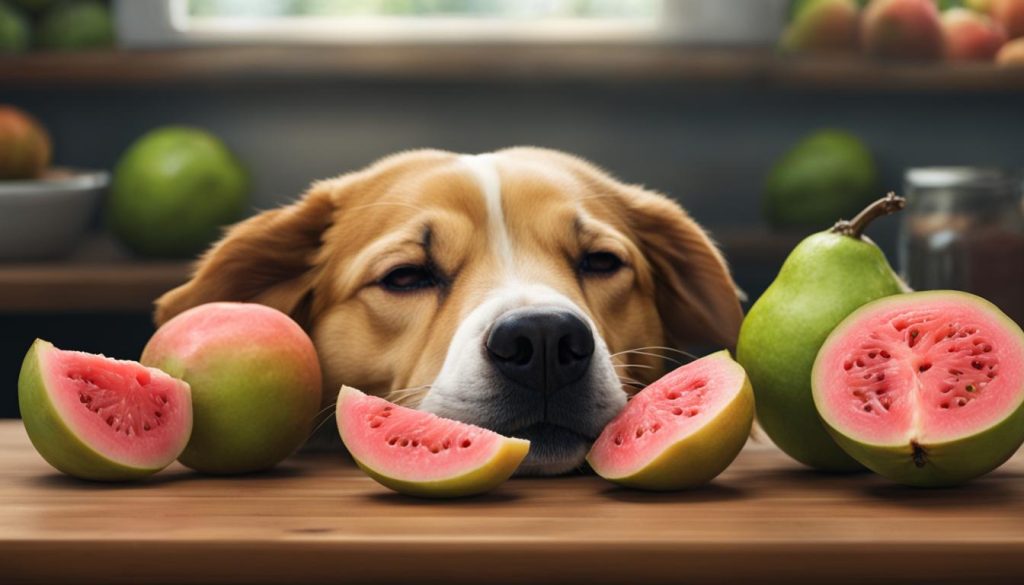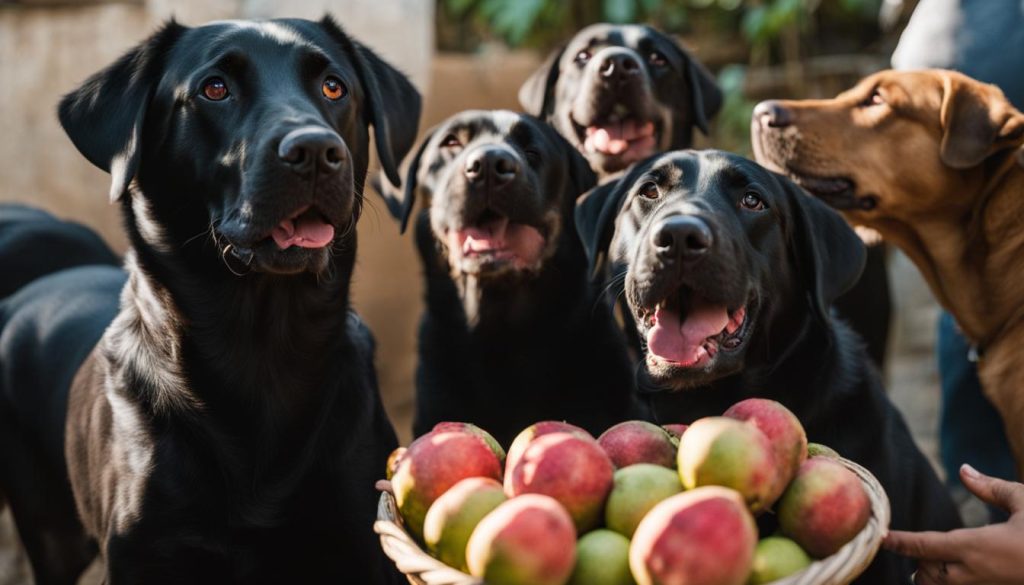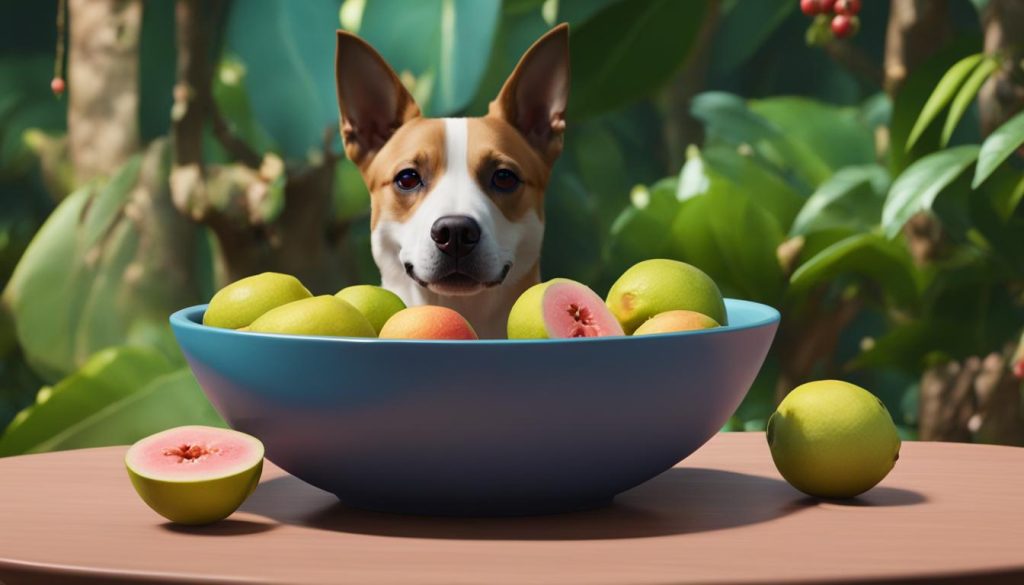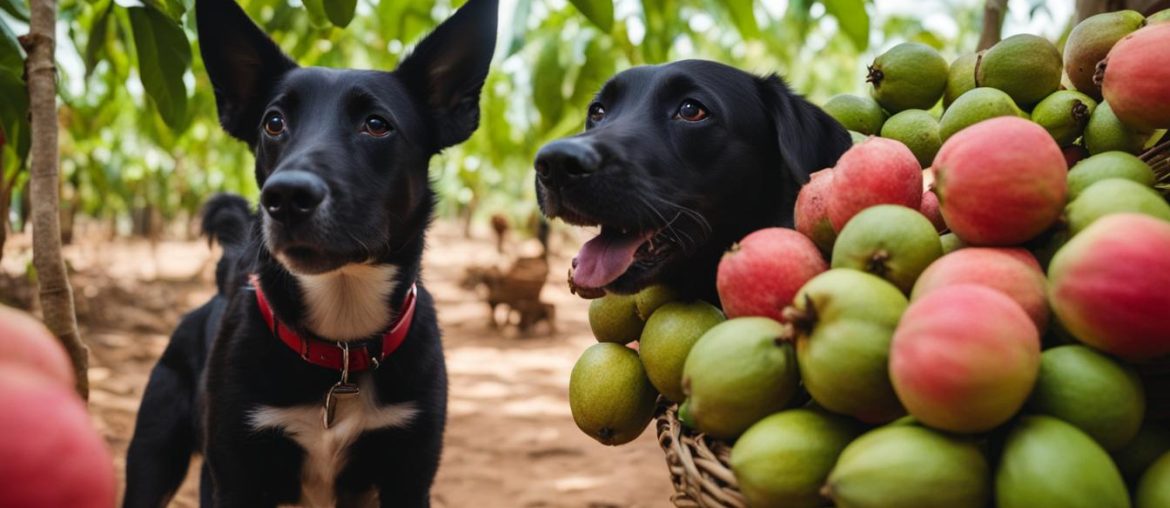Guava is a delicious and nutritious fruit that many of us enjoy. But as a responsible pet owner, you might wonder if it’s safe to share this tropical delight with your furry friend. In this article, I will answer all your questions about dogs and guava consumption, addressing topics such as the safety of guava for dogs, its health benefits, feeding guidelines, and potential allergies. So, let’s dive in and explore the world of dogs and guava!
Key Takeaways:
- Guava is safe for dogs to eat in moderation, offering essential vitamins and minerals.
- It is important to remove the rind and seeds before feeding guava to your dog.
- Follow the 90/10 rule, where 90% of your dog’s nutrition comes from their regular food and 10% can be supplemented with fruits, veggies, grains, and treats.
- Monitor your dog for any signs of allergies or intolerances when introducing new foods.
- Consult your veterinarian if you have any concerns or questions about your dog’s diet.
Benefits of Guava for Dogs

Guava is a nutrient-rich fruit that offers multiple health benefits for dogs. It contains vitamins A, C, K, and B, as well as minerals like calcium, potassium, phosphorus, and magnesium. These nutrients support the immune system, promote healthy metabolism, aid in bone health and eye health, and contribute to a healthy coat and skin. Additionally, guava is high in antioxidants, which help eliminate environmental toxins from the body and reduce the risk of certain diseases.
The dietary fiber present in guava also promotes regular digestion in dogs. Including guava in your dog’s diet can provide them with a tasty and nutritious treat, while also adding variety to their meals. However, it is important to feed guava to dogs in moderation, as excessive consumption can lead to digestive upset and potential weight gain. Remember to remove the rind and seeds before feeding guava to your furry friend to prevent any choking hazards or discomfort during digestion.
Overall, guava is a safe and healthy fruit that can be beneficial for dogs when given in appropriate amounts. It is important to introduce new foods slowly and observe your dog’s reaction to ensure they tolerate guava well. If you have any concerns or notice any adverse reactions, consult with your veterinarian for further guidance.
How to Safely Feed Guava to Your Dog

Feeding guava to your dog can be a healthy and tasty addition to their diet, but it’s important to do so safely. To ensure your dog’s safety and to prevent any digestive issues, follow these guidelines:
1. Remove the Rind and Seeds
Prior to feeding your dog guava, make sure to remove the rind and seeds. The rind can be a choking hazard, and the seeds may cause discomfort during digestion. Cut the guava into appropriate-sized pieces for your dog’s breed and size.
2. Start with Small Portions
When introducing guava to your dog’s diet for the first time, start with small portions. This allows you to observe their reaction and ensure they don’t have any allergies or sensitivities to this fruit. Monitor your dog for any signs of discomfort or digestive upset.
3. Follow the 90/10 Rule
Remember to follow the 90/10 rule when it comes to feeding your dog. This means that 90% of their nutrition should come from their regular food, while the remaining 10% can be supplemented with fruits, veggies, grains, and treats like guava. This ensures a balanced and healthy diet for your furry friend.
By following these guidelines, you can safely and responsibly incorporate guava into your dog’s diet. Please be aware that every dog is different, so it’s essential to monitor their reaction to guava and consult your veterinarian if you have any concerns. Now that you know how to safely feed guava to your dog, you can enjoy watching them enjoy this delicious and nutritious fruit!
Other Safe Fruits for Dogs
While guava is a safe and nutritious fruit for dogs, there are many other fruits that you can incorporate into your canine companion’s diet. These fruits provide a variety of flavors and nutrients to keep your dog both happy and healthy. Here are some other safe fruits for dogs:
| Fruit | Benefits |
|---|---|
| Peaches | Rich in vitamins A and C, promotes healthy skin and boosts the immune system. |
| Bananas | High in potassium and fiber, aids in digestion and supports heart health. |
| Pomegranate | Loaded with antioxidants, improves cardiovascular health and reduces inflammation. |
| Plums | Contains vitamins A and C, helps maintain a healthy immune system and supports bone health. |
| Nectarines | Packed with vitamins A and C, supports healthy eyesight and boosts the immune system. |
| Oranges | High in vitamin C and fiber, strengthens the immune system and aids in digestion. |
These fruits can be served fresh or frozen, but remember to remove any seeds or pits that could pose a choking hazard. Always introduce new fruits slowly and in small quantities to ensure your dog tolerates them well. Keep in mind that while fruits are nutritious, they should only make up a small portion of your dog’s overall diet.
It is important to note that while these fruits are generally safe for dogs, every dog is different. Some dogs may have specific allergic reactions or intolerances to certain fruits. Always monitor your dog closely when introducing new foods and consult with your veterinarian if you have any concerns or notice any adverse reactions.
The Canine Diet
Dogs have specific dietary needs that must be met to ensure their overall health and well-being. While they are omnivores and can consume certain human foods, it is essential to provide them with a balanced diet that fulfills their nutritional requirements.
The canine diet should primarily consist of a high-quality commercial dog food that is appropriate for their age, size, and breed. These dog foods are formulated to provide the necessary balance of protein, carbohydrates, fats, vitamins, and minerals that dogs need to thrive. It is important to choose a dog food that is made from high-quality ingredients and free from artificial additives.
While dogs can safely consume some human foods, it is crucial to be aware of which foods are safe and which ones to avoid. Some human foods, such as chocolate, grapes, onions, garlic, and avocados, can be toxic to dogs and should never be fed to them. Additionally, certain seasonings and spices that are commonly used in human food, such as salt, should be avoided as they can be harmful to dogs in large quantities.
“A well-balanced canine diet consists of a high-quality commercial dog food supplemented with appropriate fruits and vegetables.”
In addition to commercial dog food, it is beneficial to supplement your dog’s diet with appropriate fruits and vegetables. These can provide additional nutrients and variety to their meals. However, it is essential to choose dog-friendly fruits and vegetables and prepare them in a safe and appropriate manner.
Fruits and vegetables that are safe for dogs include:
- Apples (without seeds)
- Bananas
- Blueberries
- Carrots
- Cranberries
- Green beans
- Pumpkin (cooked and plain)
- Sweet potatoes (cooked and plain)
When feeding fruits and vegetables to your dog, it is important to wash them thoroughly and remove any seeds, pits, stems, or leaves that could pose a choking hazard or be toxic. It is also crucial to introduce new foods gradually and monitor your dog for any signs of allergies or sensitivities.
Overall, providing a well-balanced canine diet that consists of a high-quality commercial dog food supplemented with appropriate fruits and vegetables is key to ensuring your dog’s optimal health and nutrition.
| Food | Can Dogs Eat It? |
|---|---|
| Apples (without seeds) | Yes, in moderation |
| Bananas | Yes, in moderation |
| Blueberries | Yes, in moderation |
| Carrots | Yes, in moderation |
| Cranberries | Yes, in moderation |
| Green beans | Yes, in moderation |
| Pumpkin (cooked and plain) | Yes, in moderation |
| Sweet potatoes (cooked and plain) | Yes, in moderation |
Proper Feeding Etiquette for Dogs

When it comes to feeding your dog, establishing proper feeding etiquette is essential for their manners and overall well-being. By following a few simple guidelines, you can ensure a healthy and respectful relationship with your furry friend.
Designated Feeding Areas
It is important to have designated feeding areas for your dog. This helps them associate these areas with positive experiences and prevents them from begging or searching for food in other parts of the house. Choose a quiet spot where your dog can eat without distractions or interruptions.
Waiting Patiently
Teaching your dog to wait patiently before being given food is a fundamental aspect of feeding etiquette. This practice promotes patience, respect, and control. Train your dog to sit or stay calmly until you give them the signal to eat. Avoid reinforcing behaviors like begging or jumping by not giving in to their demands during mealtime.
Preventing Food Theft
It is important to prevent your dog from stealing food from counters and tables. This not only prevents them from consuming potentially harmful substances but also establishes boundaries and reinforces good behavior. Keep food out of reach and teach your dog the “leave it” command to discourage them from attempting to take food that is not intended for them.
Proper Portion Sizes
Offering small pieces of food, especially when introducing new foods, helps prevent choking hazards and ensures your dog can safely consume their meals. Avoid overfeeding by following portion guidelines recommended by your veterinarian or pet food manufacturer. Monitoring your dog’s weight and adjusting their portion sizes accordingly is key to maintaining a healthy diet.
| Proper Feeding Etiquette | Benefits |
|---|---|
| Designated feeding areas | Prevents food scavenging and promotes positive mealtime behavior. |
| Waiting patiently | Promotes patience, respect, and control while preventing begging. |
| Preventing food theft | Establishes boundaries and reinforces good behavior. |
| Proper portion sizes | Prevents overfeeding and helps maintain a healthy weight. |
Remember to always supervise your dog while they eat and provide them with plenty of fresh water. Proper feeding etiquette not only ensures a harmonious mealtime experience but also promotes a healthy and balanced diet for your beloved companion.
Signs of Food Allergies or Intolerances
When introducing new foods like guava to your dog, it is important to be aware of any potential food allergies or intolerances they may have. Dogs, like humans, can develop allergic reactions or sensitivities to certain foods, and guava is no exception.
The signs of food allergies or intolerances in dogs can vary, but common symptoms include itching, redness or irritation of the skin, gastrointestinal issues such as vomiting and diarrhea, ear infections, and even respiratory problems. If you notice any of these signs after feeding your dog guava or any other new food, it is important to consult with your veterinarian for further evaluation.
It’s worth noting that not all dogs will have allergic reactions or sensitivities to guava or other fruits, but it’s always better to err on the side of caution and monitor your dog’s reactions. Your veterinarian can conduct tests to determine if your dog has a specific food allergy or intolerance and provide guidance on the best diet for their individual needs.
Remember, every dog is unique, and what works for one dog may not work for another. By staying vigilant and paying attention to any signs of food allergies or intolerances, you can ensure that your furry friend stays happy and healthy.
Types of Guava and Precautions
When it comes to feeding guava to dogs, it is important to be aware of the different types of guava available and take necessary precautions to ensure the safety and well-being of your furry friend. Here are some types of guava that are safe for dogs to consume:
| Types of Guava | Description |
|---|---|
| White Guava | A popular variety with a sweet and tropical flavor. |
| Red Guava | Known for its vibrant red flesh and delicious taste. |
| Pineapple Guava | Named after its pineapple-like flavor, it is a unique and refreshing option. |
| Apple Guava | Has a crisp and slightly tart flavor, resembling a combination of apple and pear. |
| Thai Guava | A tropical variety with a fragrant aroma and sweet taste. |
Regardless of the type of guava you choose to feed your dog, it is crucial to take certain precautions. Make sure to remove the rind and seeds, as they can be a choking hazard and may cause discomfort during digestion. Additionally, be cautious about the amount of guava given to your dog, as excessive consumption can lead to digestive upset and potential weight gain. Start with small portions and observe your dog’s reaction before offering more guava.
Remember, while guava is a safe and healthy fruit for dogs, it should be given as a supplement or treat rather than a main source of nutrition. Following a balanced diet and considering your dog’s specific dietary needs is essential for their overall well-being. If you have any concerns or questions regarding feeding guava to your dog, it is always best to consult with your veterinarian for personalized advice.
The Verdict: Guava is Safe for Dogs
After examining the various aspects of guava consumption for dogs, it can be concluded that guava is indeed safe for dogs to eat. This nutrient-rich fruit provides a wide range of health benefits due to its high content of essential vitamins and minerals. From boosting the immune system to promoting healthy digestion, guava can be a valuable addition to a dog’s diet when fed in moderation.
However, it is essential to exercise caution when feeding guava to dogs. The rind and seeds should always be removed, as they can pose a choking hazard and cause discomfort during digestion. Additionally, guava should only be offered as a supplement or treat, following the 90/10 rule, where the majority of a dog’s nutrition comes from their regular food. Monitoring your dog’s reaction to guava and observing their digestive system is crucial to ensure it agrees with them and does not cause any adverse effects.
Remember that every dog is unique, and while guava is generally safe for consumption, some dogs may have allergies or sensitivities to this fruit. It is important to introduce guava gradually and in small quantities to monitor your dog for any signs of allergies or intolerances. If you notice any adverse reactions, such as itching, upset stomach, or diarrhea, it is best to consult with your veterinarian for guidance.
Wrapping Up
To summarize, guava is a safe and nutritious fruit for dogs to consume. It offers numerous health benefits due to its rich content of essential vitamins and minerals. By incorporating guava into your dog’s diet in moderation and following proper feeding etiquette, you can provide them with a tasty and healthy treat.
Remember to remove the rind and seeds before offering guava to your dog, as they can be a choking hazard. Additionally, observe your dog for any signs of allergies or intolerances when introducing guava or any new food. If you have any concerns, it is always best to consult your veterinarian for guidance.
Dogs and guava consumption can go hand in hand, as long as it is done in a responsible manner. Enjoy the benefits of guava as you enhance your dog’s diet and overall well-being.
FAQ
Can dogs eat guava?
Yes, guava is safe and beneficial for dogs to consume in moderation.
What are the health benefits of guava for dogs?
Guava is packed with essential vitamins and minerals that support the immune system, aid in digestion, and promote healthy metabolism, bone health, and eye health in dogs.
How should I feed guava to my dog?
It is important to remove the rind and seeds of guava before feeding it to your dog. Cut the fruit into appropriate-sized pieces and start with small portions to monitor your dog’s reaction.
Are there other fruits that are safe for dogs to eat?
Yes, several fruits, such as peaches, bananas, strawberries, and watermelon, are safe and beneficial for dogs to consume. However, grapes and raisins should be avoided as they can be toxic to dogs.
Can dogs eat human food?
Dogs can safely consume certain human foods, but it is important to provide them with a balanced diet that meets their specific dietary needs. Processed human foods high in salt, sugar, and preservatives can negatively impact a dog’s health.
What is proper feeding etiquette for dogs?
It is important to establish proper feeding etiquette for dogs, including teaching them to wait calmly before being given food and preventing them from begging or stealing food from counters and tables.
What are the signs of food allergies or intolerances in dogs?
Symptoms of food allergies or intolerances in dogs may include itching, irritability, upset stomach, diarrhea, or other digestive issues. If you notice any adverse reactions, it is best to consult your veterinarian.
Are there any precautions to take when feeding guava to dogs?
When feeding guava to dogs, it is important to remove the rind and seeds, as they can be a choking hazard. Additionally, guava should be given in moderation to avoid digestive upset and potential weight gain.
Can all types of guava be safely consumed by dogs?
Yes, all types of guava, including white guava, red guava, pineapple guava, apple guava, and Thai guava, are safe for dogs to consume as long as the rind and seeds are removed.
Is guava safe for dogs?
Yes, guava is safe for dogs to consume in moderation. It provides essential nutrients and can be a healthy addition to their diet.






